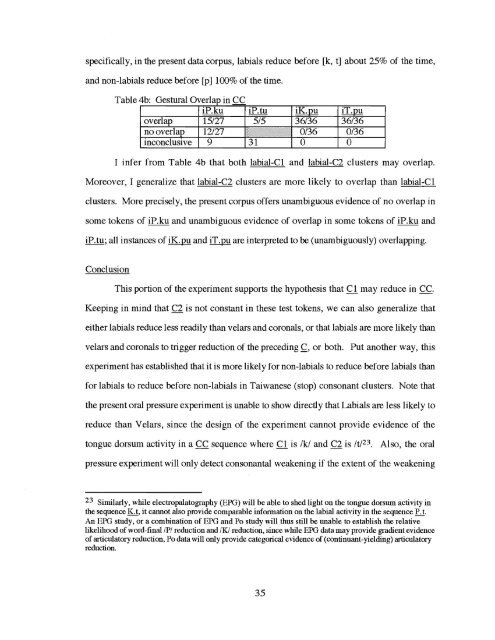A Phonetically-Based Optimality Theoretic Account of Consonant ...
A Phonetically-Based Optimality Theoretic Account of Consonant ...
A Phonetically-Based Optimality Theoretic Account of Consonant ...
Create successful ePaper yourself
Turn your PDF publications into a flip-book with our unique Google optimized e-Paper software.
specifically, in the present data corpus, labials reduce before [k, t] about 25% <strong>of</strong> the time,<br />
and non-Iabials reduce before [p] 100% <strong>of</strong> the time.<br />
Table 4b: Gestural Overlap in CC<br />
iP.ku iP.tu<br />
overlap 15/27 5/5 36/36 36/36<br />
0/36 0/36<br />
inconclusive 9 31 o o<br />
I infer from Table 4b that both labial-C1 and labial-C2 clusters may overlap.<br />
Moreover, I generalize that labial-C2 clusters are more likely to overlap than labial-C1<br />
clusters. More precisely, the present corpus <strong>of</strong>fers unambiguous evidence <strong>of</strong> no overlap in<br />
some tokens <strong>of</strong> iP.ku and unambiguous evidence <strong>of</strong> overlap in some tokens <strong>of</strong> iP.ku and<br />
iP.tu; all instances <strong>of</strong> iK.pu and iT.pu are interpreted to be (unambiguously) overlapping.<br />
Conclusion<br />
This portion <strong>of</strong> the experiment supports the hypothesis that C 1 may reduce in CC.<br />
Keeping in mind that C2 is not constant in these test tokens, we can also generalize that<br />
either labials reduce less readily than velars and coronals, or that labials are more likely than<br />
velars and coronals to trigger reduction <strong>of</strong> the preceding C, or both. Put another way, this<br />
experiment has established that it is more likely for non-Iabials to reduce before labials than<br />
for labials to reduce before non-Iabials in Taiwanese (stop) consonant clusters. Note that<br />
the present oral pressure experiment is unable to show directly that Labials are less likely to<br />
reduce than Velars, since the design <strong>of</strong> the experiment cannot provide evidence <strong>of</strong> the<br />
tongue dorsum activity in a CC sequence where C1 is /k/ and C2 is /t/ 23 • Also, the oral<br />
pressure experiment will only detect consonantal weakening if the extent <strong>of</strong> the weakening<br />
23 Similarly, while electropalatography (EPG) will be able to shed light on the tongue dorsum activity in<br />
the sequence K. t, it cannot also provide comparable information on the labial activity in the sequence P. t.<br />
An EPG study, or a combination <strong>of</strong> EPG and Po study will thus still be unable to establish the relative<br />
likelihood <strong>of</strong> word-final IPI reduction and IK/ reduction, since while EPG data may provide gradient evidence<br />
<strong>of</strong> articulatory reduction, Po data will only provide categorical evidence <strong>of</strong> (continuant-yielding) articulatory<br />
reduction.<br />
35
















